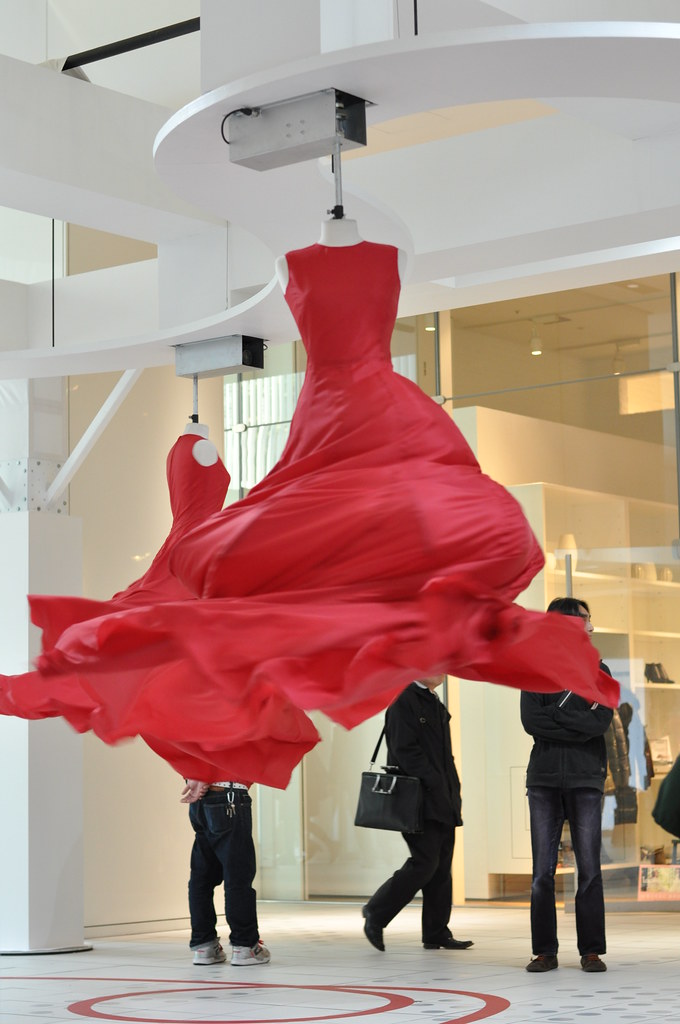An Ars Electronica exhibition in an Osaka shopping mall at the nexus of glamorous and conspiratorial elements set into motion
“Art meets commerce, and during the Christmas shopping season no less, which makes its presence felt in Japan as well. One is impressed to see that at this particular interface, art is unchallenged by competition and can be worked out in ways that differ completely from what one is accustomed to.” – Martin Honzik, curator

It’s hard to believe that artistic encounters in the atrium of a shopping mall can simultaneously be so glamorous and conspiratorial as was the case at Ars Electronica’s recent exhibition in BREEZÉ BREEZÉ in Osaka. Conspiratorial in the sense that cryptic hidden elements emerged—for example, when your partner’s pulse is placed into your hand in the form of a throbbing electronic mechanism (Heartbeat Picnic, a project by Junji Watanabe, Yui Kawaguchi, Kyosuke Sakakura & Hideyuki Ando; www.junji.org/heartbeatpicnic). And conspiratorial also in the sense that you could use the Ars Electronica Futurelab’s Shadowgram project to remain incognito while depositing communiqués containing discreet statements on the current situation in Japan, and confronting its people’s wishes and hopes for a better year in 2012 (Flickr).

Nevertheless, the centerpiece of the exhibition was Ursula Neugebauer’s spinning dresses whose pleats unfolded the emergence of absolute glamour, whereby the thus-revealed secret eroticism of the rotating and raised skirts called to mind ones adolescent longing to finally catch a glimpse of what’s hidden beneath that whirling mass of fabric (www.ursula-neugebauer.de). The unobtrusive fairy-tale world of Innocence got passers-by involved—regardless of whether they tarried a while or continued past on their Christmas shopping spree (Pressinfo). Glamorous as well is the Ars Wild Card workshop project (Website Ars Wild Card) that enabled visitor participation in the exhibition via specially developed applications for iPod Touch and iPhone. Those in attendance received information about the projects and portrayed themselves with the works of art to thus become a part of the exhibition, whereby they could view their activities online and also get them to go in the form of a postcard. Likewise participative is João Wilbert’s Exquisite Clock (www.exquisiteclock.org), an extraordinary work that takes snapshots of everyday life as the basis for an encounter with the infinite forms of representing numbers and time.

For more than 32 years, Ars Electronica has been working in public spaces, commissioning projects designed for downtown cityscapes and independently producing events in diverse metropolitan settings. This urban public realm has been expanded in recent years to include so-called functional public spaces such as shopping arcades, department stores, airport terminals and train stations. And now a mall in Osaka. One thing the experience we had in Osaka in December 2011 demonstrated especially impressively is how seamlessly media art can be integrated into people’s everyday lives without the art content having already been announced as such by the very nature of the exhibition venue itself. This is a challenge and, admittedly, this absence of an artistic context also makes us appear completely vulnerable in such functional public spaces. Since the actual purpose these sites were designed to serve is a different one altogether, what’s called for is the courage to experiment. From the very outset, this challenge was accepted unanimously and without recriminations by all involved, including the artists themselves. This contributed to the success of the project and generated new experiences with the open encounter with a public space and the people who frequent it.
More information on the exhibition on the Website.
